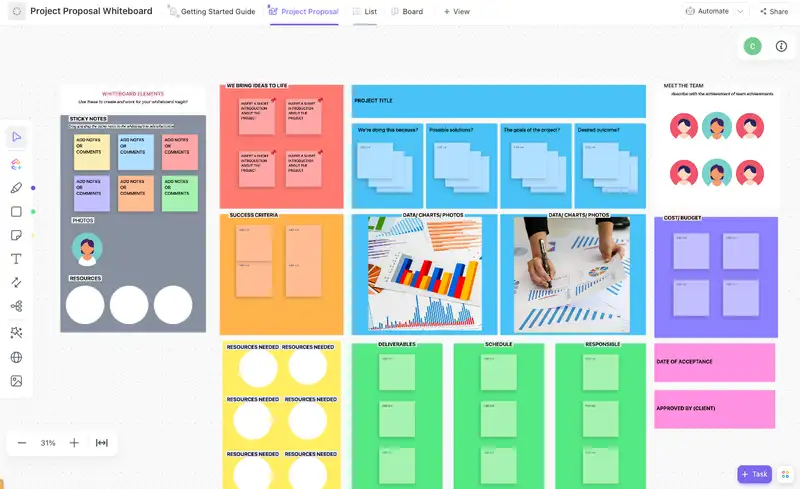

With the help of this practical Machine Learning Project Proposal Template, you can efficiently handle your tasks and improve productivity.
Machine learning projects can be complex and time-consuming, requiring careful planning and organization. But fear not! ClickUp's Machine Learning Project Proposal Template is here to simplify the process and set you up for success.
With this template, you can:
Whether you're a seasoned data scientist or just starting your machine learning journey, ClickUp's template will guide you through the proposal process, ensuring your project gets off to a flying start. Get started today and bring your machine learning ideas to life!
When it comes to machine learning projects, having a solid project proposal is essential. With the Machine Learning Project Proposal Template, you can:
ClickUp's Machine Learning Project Proposal template is designed to help you effectively plan and manage your machine learning projects. Here are the main elements of this Whiteboard template:
With ClickUp's Machine Learning Project Proposal template, you can streamline your project planning process and ensure successful execution of your machine learning projects.
If you're embarking on a machine learning project and need to create a project proposal, follow these steps to effectively use the Machine Learning Project Proposal Template in ClickUp:
Clearly state the problem you're trying to solve with your machine learning project. Identify the objective you want to achieve, whether it's improving accuracy, optimizing processes, or making predictions.
Use a Doc in ClickUp to outline the problem statement and define the project objective.
Collect relevant data that will be used for your machine learning project. This can include structured data, unstructured data, or even data from external sources. Clean and preprocess the data to ensure its quality and suitability for your project.
Use the Table view in ClickUp to organize and analyze your data, and create custom fields to track data quality and preprocessing steps.
Based on the problem and objective, choose the most suitable machine learning algorithm for your project. Consider factors such as the type of data, the desired outcome, and the available resources.
Create tasks in ClickUp to research and evaluate different machine learning algorithms, and assign team members to explore and choose the most appropriate one.
Define the architecture of your machine learning model, including the layers, nodes, and connections. Decide on the input and output layers, as well as any hidden layers, activation functions, and optimization algorithms.
Use a Whiteboard in ClickUp to visually design and iterate on your model architecture, and collaborate with your team to gather feedback.
Train your machine learning model using the collected and preprocessed data. Split the data into training and testing sets, and use appropriate evaluation metrics to assess the model's performance.
Use Automations in ClickUp to set up recurring tasks for training and evaluating the model, and create custom fields to track performance metrics and model versions.
Develop a timeline that outlines the various stages of your machine learning project, including data collection, model development, training, and evaluation. Estimate the resources and budget required for each stage.
Use a Gantt chart in ClickUp to visualize and manage your project timeline, and create custom fields to track resource allocation and budgeting.
By following these steps and leveraging the Machine Learning Project Proposal Template in ClickUp, you'll be well-equipped to plan and execute your machine learning project successfully.

Data scientists and machine learning enthusiasts can use this Machine Learning Project Proposal Template to streamline the process of pitching and executing machine learning projects.
First, hit “Get Free Solution” to sign up for ClickUp and add the template to your Workspace. Make sure you designate which Space or location in your Workspace you’d like this template applied.
Next, invite relevant members or guests to your Workspace to start collaborating.
Now you can take advantage of the full potential of this template to propose and execute machine learning projects: